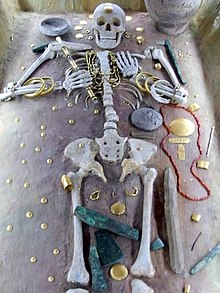| Horizon | Old Europe |
|---|---|
| Period | Chalcolithic |
| Dates | c. 4550 BC – c. 4,100 BC |
| Type site | Varna Necropolis, Solnitsata, Durankulak |
| Preceded by | Karanovo culture, Hamangia culture, Gumelnița culture |
| Followed by | Cernavodă culture |

The Varna culture was a Chalcolithic culture of northeastern Bulgaria, dated c. 4500 BC,[1][2] contemporary and closely related with the Gumelnița culture. The oldest golden artifacts in the world (4600 BC - 4200 BC) were found in the Necropolis of Varna. These artefacts are on display in the Varna Archaeological Museum.[3][4][5]
The site was accidentally discovered in October 1972 by excavator operator Raycho Marinov. Research excavation was under the direction of Mihail Lazarov and Ivan Ivanov. About 30% of the estimated necropolis area is still not excavated.[citation needed]
The Varna culture is characterized by polychrome pottery and rich cemeteries, the most famous of which are Varna Necropolis, the eponymous site, and the Durankulak lake complex, which comprises the largest prehistoric cemetery in southeastern Europe, with an adjoining coeval Neolithic settlement (published) and an unpublished and incompletely excavated Chalcolithic settlement. 294 graves have been found in the Varna necropolis, many containing sophisticated examples of the oldest gold metallurgy in the world, copper metallurgy, pottery (about 600 pieces, including gold-painted ones), high-quality flint and obsidian blades, beads, and shells.
The oldest gold jewelry in the world found in the necropolis is dated 4,600 BC to 4,200 BC.[6] Several prehistoric Bulgarian finds are considered no less old – the golden treasures of Hotnitsa, Durankulak, artifacts from the settlement of Yunatsite near Pazardzhik, the golden treasure of Sakar, as well as beads and gold jewellery found in the settlement of Solnitsata. However, Varna gold is most often called the oldest since this treasure is the largest and most diverse.[7]
The findings showed that the Varna culture had trade relations with distant lands, possibly including the lower Volga region and the Cyclades, perhaps exporting metal goods and salt from the Solnitsata rock salt mine. The copper ore used in Varna artifacts originated from the Sredna Gora mine near Stara Zagora, and Mediterranean spondylus shells found in the graves may have served as primitive currency.
- ^ Chapman, John (2012). "Varna". The Oxford Companion to Archaeology, Volume 1. Oxford University Press. p. 342. ISBN 978-0-19-973578-5.
- ^ Jeunesse, Christian (2017). "From Neolithic kings to the Staffordshire hoard. Hoards and aristocratic graves in the European Neolithic: The birth of a 'Barbarian' Europe?". The Neolithic of Europe. Oxbow Books. p. 175. ISBN 978-1-78570-654-7.
- ^ [1] Archived 2022-11-01 at the Wayback Machine Gems and Gemstones: Timeless Natural Beauty of the Mineral World, By Lance Grande
- ^ (https://www.smithsonianmag.com/travel/varna-bulgaria-gold-graves-social-hierarchy-prehistoric-archaelogy-smithsonian-journeys-travel-quarterly-180958733/)
- ^ (https://www.smithsonianmag.com/smart-news/oldest-gold-object-unearthed-bulgaria-180960093/)
- ^ Grande, Lance; Augustyn, Allison (15 November 2009). Gems and Gemstones: Timeless Natural Beauty of the Mineral World. University of Chicago Press. ISBN 9780226305110.
- ^ "Archaeologists have discovered the oldest treasure in the world - Afrinik". 15 May 2021.